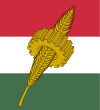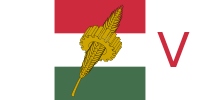Unity Party (Hungary)
Party of Hungarian Life Magyar Élet Pártja | |
|---|---|
 Logo of the party seen during the early to late 1930s. | |
| Leader |
Gyula Gömbös (1932-1936) Béla Imrédy (1938-1939) Miklós Kállay (1942-1944) |
| Founded | 2 February 1922 |
| Dissolved | 23 March 1944 |
| Merger of | KNEP and OKGFP |
| Headquarters | Budapest |
| Ideology |
Szeged Idea[1][2] Christian nationalism Agrarianism |
| Political position | Far-right |
| Party flag | |
 | |
The Unity Party (Hungarian: Egységes Párt) was a Hungarian political party founded in 1921.[3] The party was founded by István Bethlen and shortly afterwards won a majority of seats in the Hungarian parliament in the 1922 elections, becoming the governing party with Bethlen becoming Prime Minister of Hungary.[4] On 27 October 1932, the party was renamed National Unity Party (Hungarian: Nemzeti Egység Pártja), while since 2 February 1939 the name was Party of Hungarian Life (Hungarian: Magyar Élet Pártja).
The party, initially more agrarian and conservative, grew similar to fascist movements, establishing a militia.[5] It first became the ruling party of Hungary from 1932 to 1936 under the leadership of Gyula Gömbös, who was Prime Minister of Hungary during that time.[6] Gömbös declared the party's intention to achieve "total control of the nation's social life".[7] In the 1935 Hungarian Election, Gömbös promoted the creation of a "unitary Hungarian nation with no class distinctions".[8]
The party won a huge majority of the seats of the Hungarian parliament in the Hungarian election of May 1939.[9] It won 72 percent of the parliament's seats and won 49 percent of the popular vote in the election.[10] This was a major breakthrough for the far-right in Hungary.[10] The party promoted nationalist propaganda and its members sympathized with the Nazi Arrow Cross Party.[10]
A faction of the most pro-National Socialist members led by the party's former leader Béla Imrédy split from the party October 1940 to form the Party of Hungarian Renewal (Magyar Megújulás Pártja) that sought to explicitly solve the Jewish Problem.
References
- ↑ Stanley G. Payne. A history of fascism, 1914-1945. Oxon, England, UK: Routledge, 2005. Pp. 269.
- ↑ Miklós Lackó. "Arrow-cross men, national socialists, 1935-1944", Studia historica, Magyar Tudományos Akadémia. Volume 61. Akadémiai Kiadó, 1969. Pp. 65.
- ↑ Gregory Curtis Ference. Chronology of 20th-century eastern European history. Gale Research, Inc., 1994. Pp. 226.
- ↑ Vincent E. McHale, Sharon Skowronski. Political Parties of Europe: Albania-Norway. Greenwood Press, 1983. Pp. 500.
- ↑ Philip Morgan. Fascism in Europe, 1919-1945. London, England, UK: Routledge, 2003. Pp. 76-77.
- ↑ Stanley G. Payne. A history of fascism, 1914-1945. Oxon, England, UK: Routledge, 2005. Pp. 269.
- ↑ Philip Morgan. Fascism in Europe, 1919-1945. London, England, UK: Routledge, 2003. Pp. 76.
- ↑ F. L. Carsten. The rise of fascism. Berkeley and Los Angeles, California, USA: University of California Press, 1982. Pp. 173.
- ↑ Peter F. Sugar, Péter Hanák. A History of Hungary. First paperback edition. Bloomington, Indiana, USA: Indiana University Press, 1994. Pp. 341.
- 1 2 3 Georgi Karasimeonov. Cleavages, parties, and voters: studies from Bulgaria, the Czech Republic, Hungary, Poland, and Romania. Greenwood Publishing Group, 1999. Pp. 70.